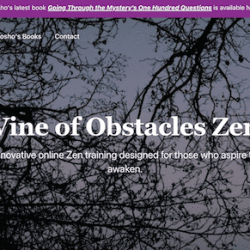The main reason being that sheep are easy to keep in line. As soon as the word “need” is barked (as in “the center needs…” or “your practice needs…”), a sheep will snap too and do what’s asked. It is convenient for any spiritual group to have a nice sized flock. Congregants are even called “flock” in Christianity and you-know-who is the shepard. Anyway, the virtues of sheep are often presented as the only way to be “spiritual.” That’s a limitation due to the eye sight of sheep.
Strangely, though, Zen sheep don’t think they’re sheep and don’t even notice that they’re getting sheared (a.k.a., “fund raisers” and “temple positions”) from time to time. Make a motion at your next sangha meeting to change the word “membership” to “flock” and hope the path to the exit is clear.
Zen sheep tend to think they’re not sheep – they might even bleat the Diamond Sutra to this effect. Zen sheep are especially strange in this way. Zen practice, after all, calls for a lot of conformity (on the surface) and yet attracts sheep who think they’re lone wolves. This all creates an odd inner dynamic. Especially when conformity is convenient and quite benefical (in the short term) for the group and for the teacher.
In the midst of most groups there is another type, the little baby wild fox.
Originally, they get taken in by the sheep out of compassion. The sheep care for these little ones in their sheep ways, although that isn’t quite what baby wild fox need. Still things go well for a while.
One thing that goes especially well is zazen. That’s one way to spot a wild fox puppy. The Zen teacher is also often quite fond of the little wild fox because Zen teachers (often grown up canines of some kind) are interested in those who are crazy about zazen. And the little fox pups throw themselves into sitting with an uncommon spirit of enthusiasm. The sheep will follow the form and baaa on and on about the form, but their spirit is often rather baaaa.
So the little baby wild fox begins by totally identifying with the herd but a nagging feeling emerges that s/he is different in some basic way. By the time the wild fox reaches those trouble teenaged years, s/he tries even harder to be a sheep – even harder than all the sheep try to be sheep.
But then the wild fox grows up and sooner or later something happens where the wild fox gets a glimpse of her/his wild fox nature. That’s when things get interesting. In some groups, the wild fox is then shown to the door. In others, the wild foxes’ wild fox nature is pathologized and sheep kindly approach and say, “Sorry to hear you aren’t feeling well.”
The teacher’s animal type is pretty important here. As I said, most teachers are some kind of canine, but we all aren’t foxes. There are sheep dogs, of course, some collies and yes, there are wolves among us some of whom are hungry for things other than sex (fame and money, for example) … but that’s another story.
I learned from Wikipedia that a bunch of sheep can be called a flock, a herd, or a mob. When a student’s wild fox nature becomes clear, the mob nature of sheep becomes clear. They are domesticated and the wild fox is wild. The sheep define the boundary of the group and the wild fox is often exiled to just the place the grown up wild foxes like to hang – the periphery.
“Always on the outside of whatever side you’re on,” sings Bob D. about some gangster.
You might think, “If only I could find a wild fox community.” But a whole group of wild foxes become a bunch of sheep acting like wild foxes. There is no escape. A mass of sheep is necessary for any group to function. That’s just the nature of groups.
Any one Zen student may also seem to be a sheep but shape shift at some point and there you have it – a real wild fox. A thorough wild fox also ought to be able to selflessly shape shift and be a damn good sheep … for a while.
But remember: the human realm is the most opportune incarnation for dharma practice.
Peace out,
Dosho













